Ford SVT Mustang Cobra vs. Pontiac GTO

Pontiac’s GTO was credited with creating the phenomenon in 1964, while Ford’s SVT Mustang Cobra has kept the muscle-car idea alive. Now for the 2004 model year, their paths briefly intersect. The Mustang Cobra goes away after this model year, and the GTO, after a 30-year hiatus, is back. This comparison offers insight into the state of American muscle.
This story originally appeared in the July, 2004 issue of R&T. - Ed.
Talk about a reversal of roles. Coming as it does at the end of the product cycle for the current-generation Mustangs, the SVT Cobra is much truer to the original muscle-car formula than the updated Pontiac GTO. In other words, the Mustang Cobra is rude, crude and faster than all get-out. On the other hand, the GTO feels much more like a refined sports tourer. It’s probably as quick as the original GTO, with the added bonus of being able to turn right and left much better. And the Pontiac has the advantage of serving up the kind of interior fitments and sound insulation you’d expect in a luxury car.
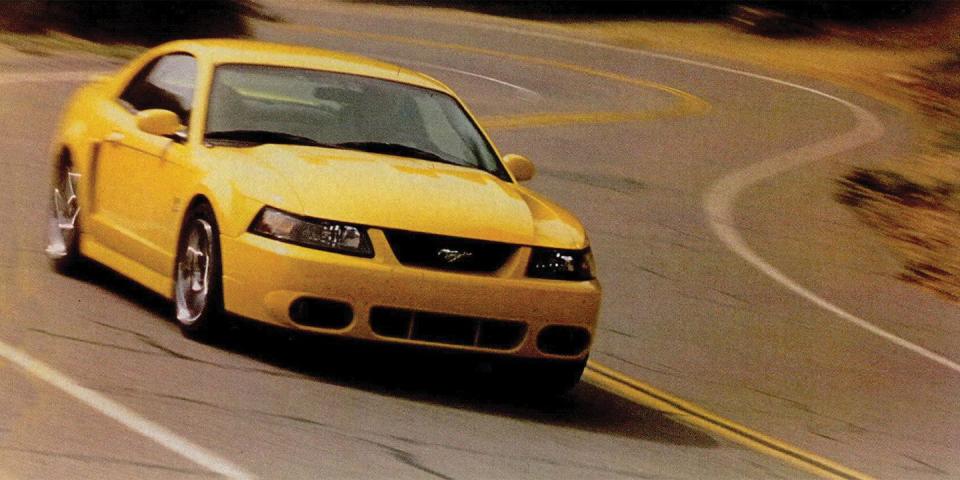
Still, I found myself drawn to the street-fighter ethos of the SVT Mustang Cobra. Its screaming yellow paint, ability to light up the rear wheels in the first three gears and massive amount of grip won me over. Despite showing its age in terms of body integrity, interior refinement, ride and build quality, the Mustang Cobra delivers in the visceral-thrills department like very few cars can in this price range.
The supercharged V-8 has a wide, readily accessible powerband that makes 2nd, 3rd or even 4th the right gear for a variety of situations. The 390 lb.-ft. of torque propelled the car to 60 mph in 5.0 seconds in our track testing and helped dust the quarter mile in 13.4 sec. at 107.0 mph.
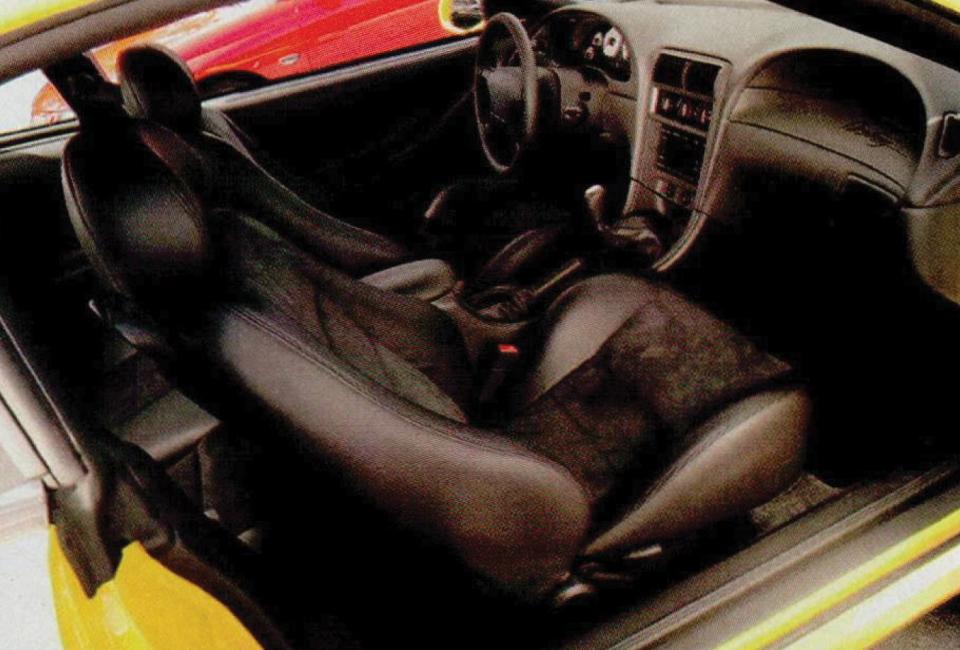
That performance edge on the drag strip also asserted itself on the skidpad. In addition to a tauter suspension than the GTO’s, the Mustang Cobra has lower-profile P275/40ZR-17 Goodyear F1 tires, which enabled the car to pull 0.88g on the skid pad. Set up with mild understeer, the Mustang Cobra cruised through our 700-ft. slalom at 65.6 mph, 2.6 mph faster than the Pontiac.
These test track numbers played out well on the real world roads of Mt. Palomar, where the Cobra felt sharp, with crisp turn-in, minimal body lean and an unflappable demeanor in the tight corners and switch backs. The GTO felt a bit more languid, exhibiting a little more body roll before taking a set. The Pontiac is a good handler; it just lacks the finely honed road manners of the Mustang, especially when pushed hard. Much of this credit also must go to the independent rear suspension developed specifically for the Cobra model, a feature SVT promises it will retain on the next-generation car.
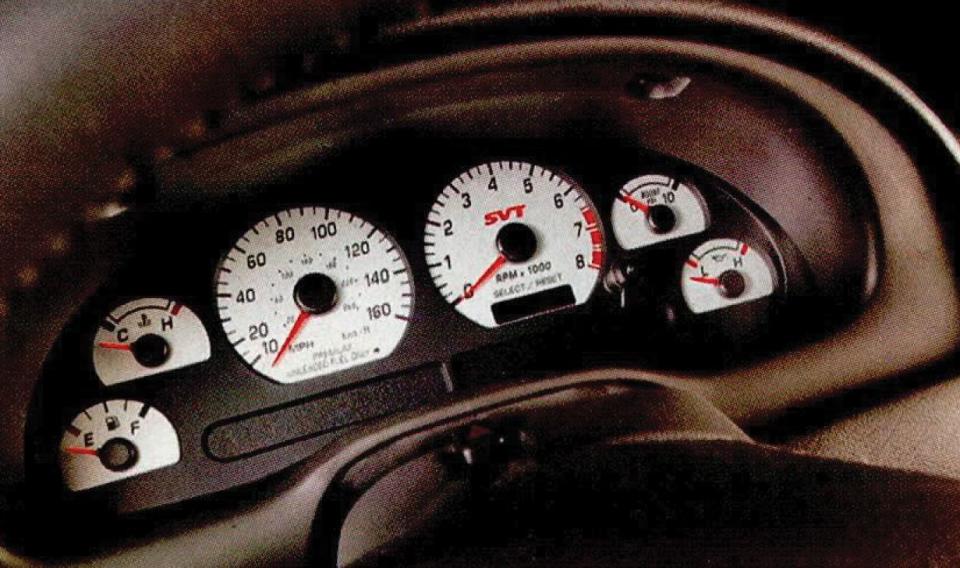
Steering is another area where the Mustang Cobra felt clearly superior. The on-center feel was accurate, providing excellent feedback, while the action felt linear without the power assist getting in the way. The GTO, on the other hand, felt a tad lighter, with a tiny bit of low-order vibration that came through on some road surfaces. The Mustang Cobra’s brakes also worked well, with a solid feel that made it easy to modulate the effort. But after one particularly spirited run down the mountain, the Mustang’s pads were visibly smoking. Nonetheless, the brakes didn’t show any signs of giving up. This stopping ability was borne out at the track where the Cobra tied the GTO in 60-0 mph stopping of 121 ft. and took just 3 ft. more than the GTO’s 218 ft. from 80 mph.
In terms of the overall package, the Mustang Cobra is much more extroverted in styling than the understated GTO. The front end is aggressive, with its large chin spoiler and driving lights flanked by brake cooling ducts. The taller hood with its power dome tips off that the engine is much taller than the stock GT’s. On the back, there is a trunklid spoiler that nicely complements the other aero bits.
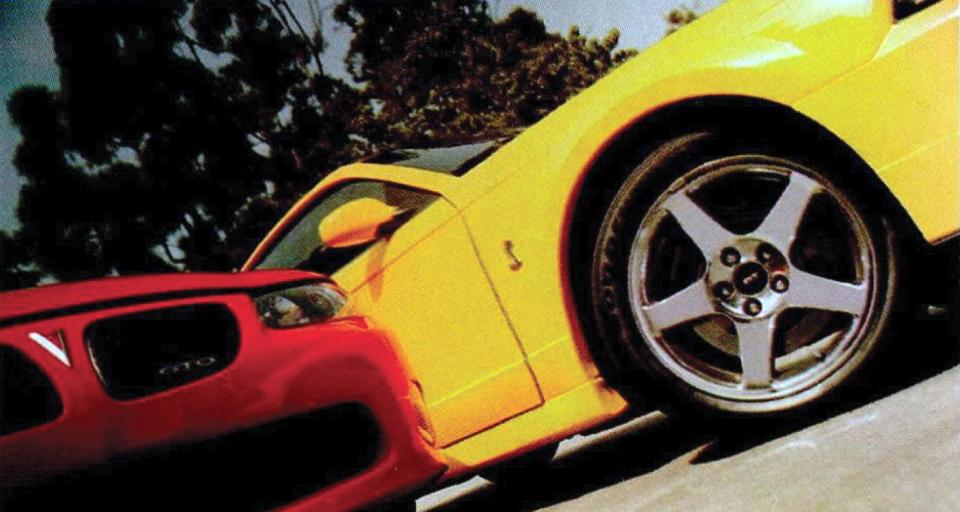
The interior is closely coupled, and the seats are firm and supportive. Since I’m part of the under-6-ft. set, I didn’t have any problems fitting into the car. The GTO, by comparison, felt much more spacious and more inviting to rear-seat passengers. But for me, a Mustang Cobra’s thrills are best experienced alone, so a smaller cabin isn’t an issue. But when it comes to lugging gear, the Mustang clearly has an advantage with nearly 2 cu. ft. extra space over the GTO’s.
If there is a downside to all the fun that can be had in the Mustang Cobra, it’s the lack of refinement. All that extra grip sacrifices ride comfort. The Mustang Cobra has a tendency to exhibit more freeway hop and transmits much more road noise and minor jolts and jostles than the GTO. There also is a lot of lash in the drivetrain, especially when tipping in or out of the throttle at lower speed. Much of this disappeared the more aggressive I got with the throttle. Also, in the engine department, the extra muscle provided by the Roots-type supercharger comes at the expense of a high-pitched whine of the induction system, which masks the rumble of the exhaust.
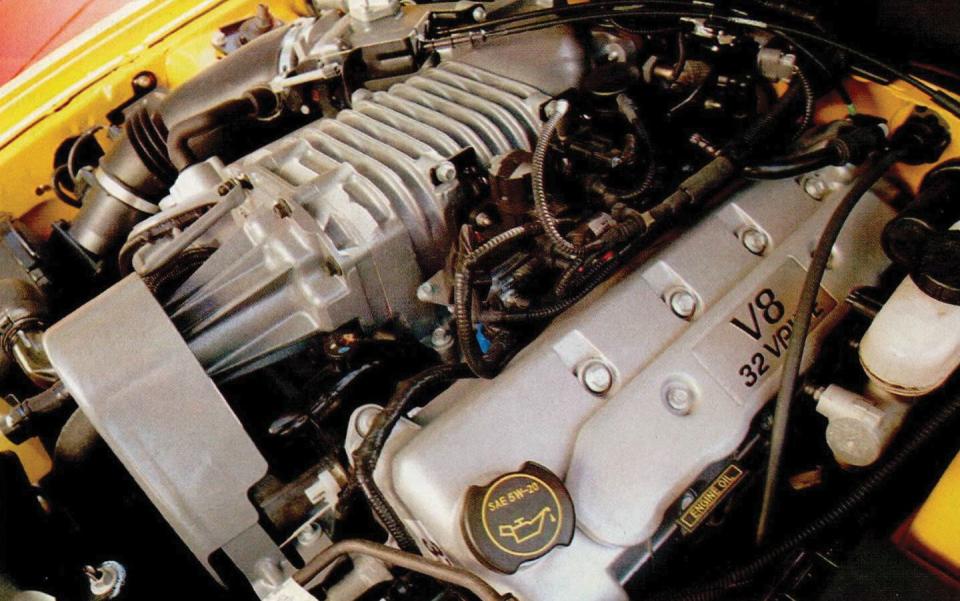
The interior has several nice appointments, like the suede inserts on the leather bucket seats and the titanium-colored instrument faces. Other interior bits, particularly around the center console, with its corporate audio and heating/air-condition ing stack, look cheap, and some of the fits aren’t what you’d expect from a car costing north of $30,000. Granted, much of the reason for spending this kind of money lies under the hood and in the chassis.
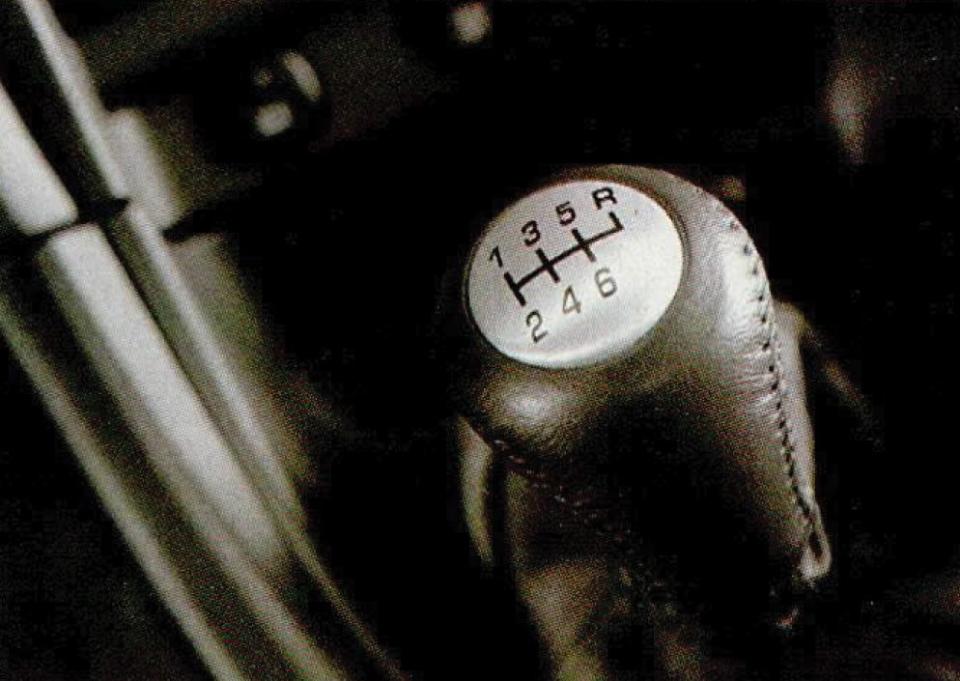
But there is no excuse for the shifter that almost fell off in my hand. The lower mounting bolt had backed itself out completely (this, on a car that was registering 1000 miles on the odo), making the shifter all floppy. I reattached the bolt and all was fine, although the Tremec 6-speed, even when the linkage is tight, is a bit notchy and not as smooth as the action on the GTO.
These flaws aside, the SVT Mustang Cobra is fast, fun and familiar. It’s a car that has not only been a part of the automotive scene for 40 years, it has also been very honest in its approach. What you see is what you get. In this last iteration of what has be come an icon, the SVT Mustang Cobra isn’t trying to reinvent or redefine any thing. It just is. Which is reason enough to have one in the garage.
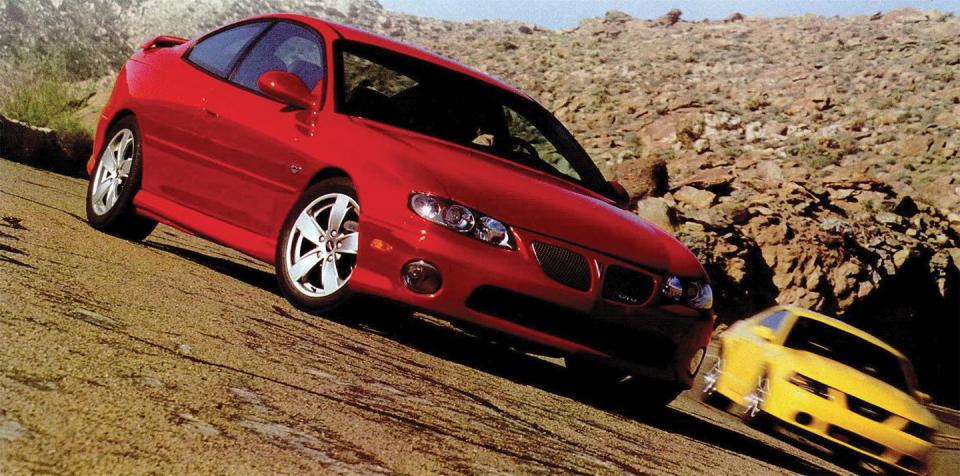
I was 16 once. Back then, all that mattered was performance. If car A was a tenth quicker to 60 mph than car B, and if it had more grip on the skidpad, well, it was clearly the better car. Sportier too. It was the car I wanted in my driveway.
How wrong I was. In the ensuing 25 years I’ve learned that numbers don’t tell the whole story. Case in point, this test. The Mustang Cobra is by far the quicker car, and it has the advantage in nearly all of our significant performance tests. But after two days of flogging these two V-8-powered rear-drive coupes amongst the blooming ocotillos of California’s Anza-Borrego state park, it’s clear to me that Pontiac’s new GTO is the superior automobile. It’s the car I now want in my driveway.
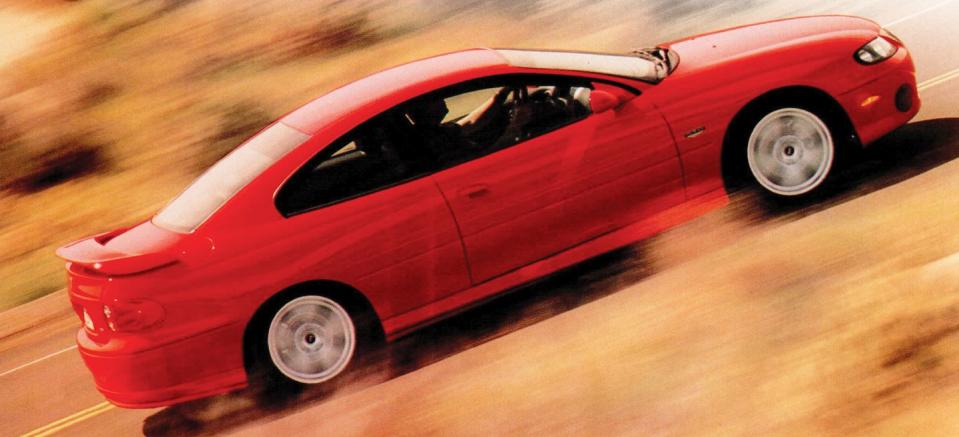
That’s because the GTO is for adults. It’s refined. It’s a true GT. It’s a car that offers Corvette thrust but won’t beat you up on a cross-country drive. Without stretching the imagination too much, it’s a car into which the vaunted GTO of 30 years ago naturally could have evolved.
The Mustang, on other hand, well, let’s just say I wish it had evolved. Ford has kept it inexpensive for so many years, which is laudable, but the company has done so continuing to build it on a Fox chassis that dates back to Carter presidency.
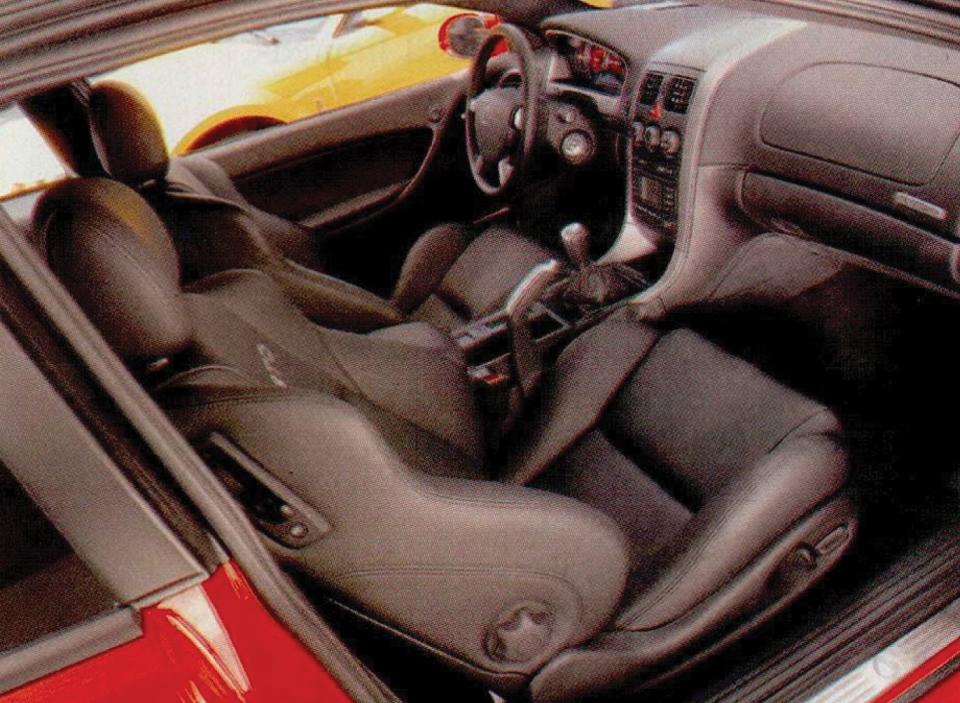
Conversely, the GTO feels new, taut, all of one piece. It doesn’t feel like an assemblage of parts; it’s solidly built, and its Opel-based chassis has comfortable suspension tuning and a roomy interior fitted with superb sport seats. Most important, the Corvette’s LS1 V-8 is the GTO’s sole powerplant, an aluminum-block V-8 that boasts great bottom -end torque yet revs to 6000 rpm without gasping for air. Also, the optional 6-speed Tremec T-56 manual gearbox- a far better choice than the GTO’s conventional 4-speed automatic- gives the GTO driver control over a drivetrain that has none of the Cobra’s bother some lash as it sends power to the independently sprung rear wheels via a standard limited-slip differential.
What’s more, the GTO seats four adults far more comfortably than the Mustang Cobra. Although getting into and out of the back of the GTO is a hassle, two people fit very well back there, in individual-style seats that offer plenty of head and leg room, the latter no doubt related to a wheelbase that’s 8.5 in. longer than the Mustang’s.
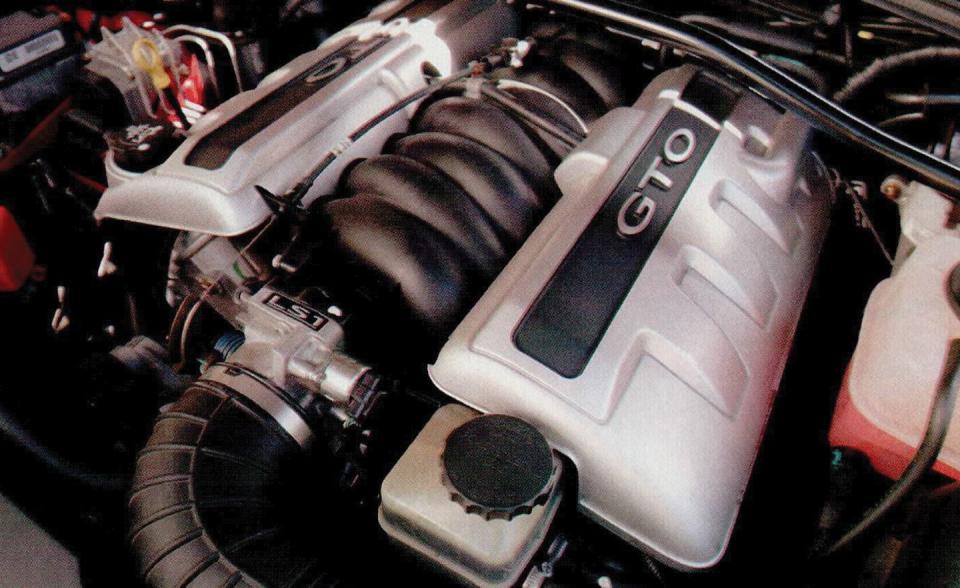
Some have criticized the GTO for being plain, for being a Holden Monaro with a Pontiac grille. Duly noted. Nevertheless, the low and wide body is sporty, and the sleek overall shape is unfettered by scoops and bulges. About the only thing I’d do to my GTO- apart from deleting the rear wing- is fit the car with 18-in. wheels and tires for a more aggressive look.
Is it odd that Pontiac has had to turn to GM’s Australian division, Holden, for a new GTO? It is, but who cares? What matters is that this new GTO is here, it’s a performance bargain at $33,000, and it’s a kick to drive. Switch the traction control off, and the U.S.-built V-8 can easily smoke the GTO’s rear tires. Or, if you prefer, it can loaf along at 1600 rpm on the highway while returning an impressive EPA highway mileage figure of 29 mpg.
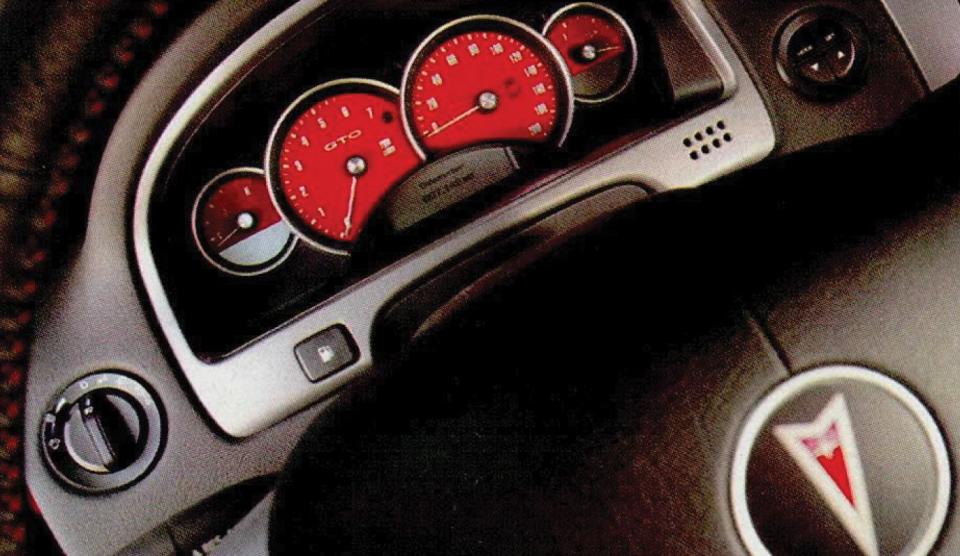
Although the GTO’s steering is a bit slower than the Cobra’s, it’s well-weighted and accurate, and the supple suspension minimizes body roll while keeping mid-corner bumps from upsetting the chassis. Mild understeer is the steady-state cornering attitude of this new Goat, but don’t fret: With its excellent 54/46 weight balance and 350 bhp on tap, it’s more than capable of entertaining tail-out antics when exiting a corner. While the skidpad figure of 0.84g is not great, it’s related to Pontiac fitting the car with 245/45ZR-17 BFGoodrich tires that have a Treadwear rating of 400. In other words, they’re built to last and don’t have the grip of the Cobra’s 275/40ZR-17 Goodyear Eagle F1s.
In driving the GTO about town, drivers will appreciate the direct linkage of the 6-speed manual. In driving the GTO about town, drivers will appreciate the direct linkage of the 6-speed manual. The clutch is not overly heavy, and its easy modulation makes for buttery smooth take offs and shifts. In the Cobra, it’s a challenge for any driver to be smooth.
And then there’s the sound. Just enough of it gets through the firewall to remind the driver that there’s a burbly V-8 underhood, one that’s not quite as powerful as the Cobra’s blown powerplant but makes much better music through its twin-tip exhaust. To me, the Cobra’s supercharged V-8 sim ply makes lots of racket, accompanied by whine from the blower. Of note, the GTO is louder than the Monaro because U.S. noise regulations aren’t as strict as Australia’s.
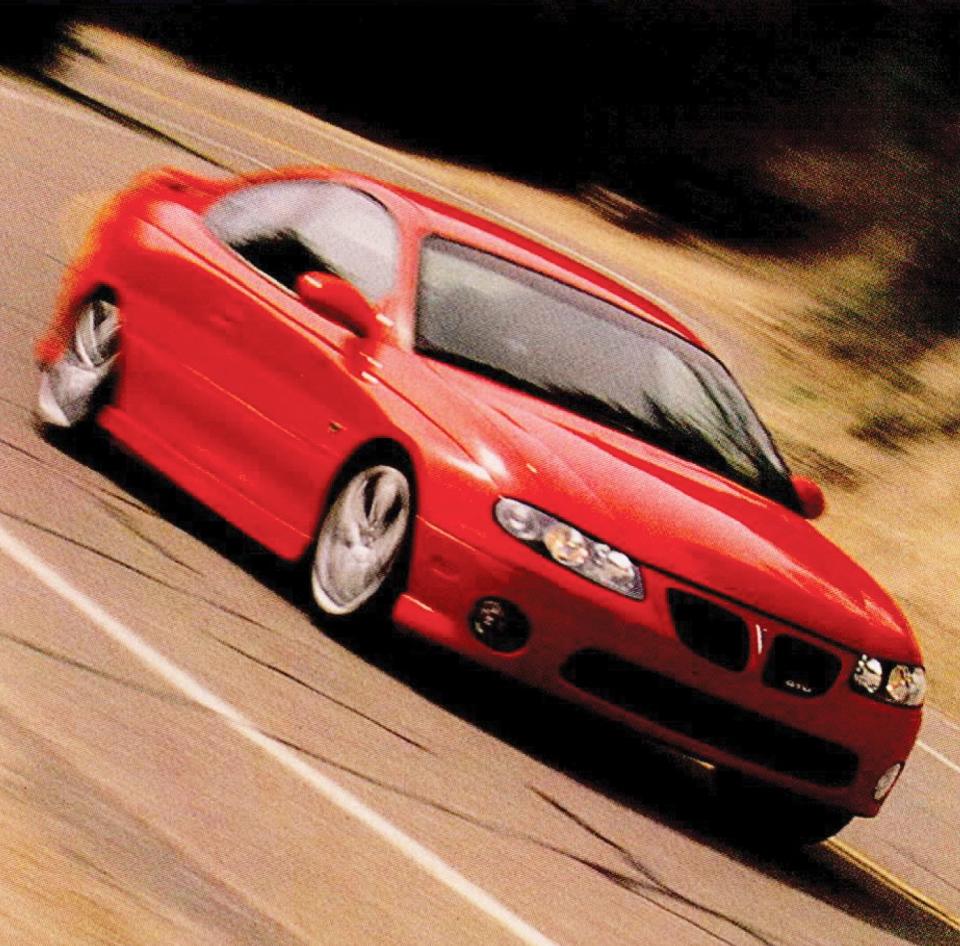
With the exception of some new Cadillacs, the GTO has the best GM interior currently available. The design is conservatively handsome, the materials are first-rate, and the 4-spoke steering wheel has a sturdy feel. The leather-covered seats are thickly bolstered and supportive, and, unlike in the Mustang, they go back far enough to accommodate taller drivers. Furthermore, the gauges are clear analog dials, though it’s fun to track speed with the digital readout on the multi-function screen just below the tachometer and speedometer.
Because the GTO’s platform is used in right-and left-hand-drive configurations, the firewall is only half height to accommodate a steering column on either side of the car. While this undoubtedly has an effect on the car’s rigidity, the GTO does have a strut tower brace to solidify the front structure.
As for complaints, there are two. The GTO has the dreaded skip-shift feature, which in certain low-rpm conditions shunts the gear lever to 4th when you’re trying to pull it back into 2nd. It’s annoying, and the only ways around it are to short-shift to a fault or to shift at higher rpm, which increases fuel consumption, defeating the feature’s purpose. I’d pull the fuse right away. Second, Pontiac hides the LS1’s rocker arm covers with plastic panels that make the V-8 look like an overhead-cam engine. That’s a pity, because the pushrod small-block heritage should be celebrated, not hidden.
And in general, the whole GTO deserves to be celebrated. It’s a return to rear-drive fun at Pontiac, and although it’s not as quick as the Cobra, it’s still much faster than the majority of other cars on the road. It’s an adult’s car, and it’s worlds more refined than Ford’s tired old Mustang.
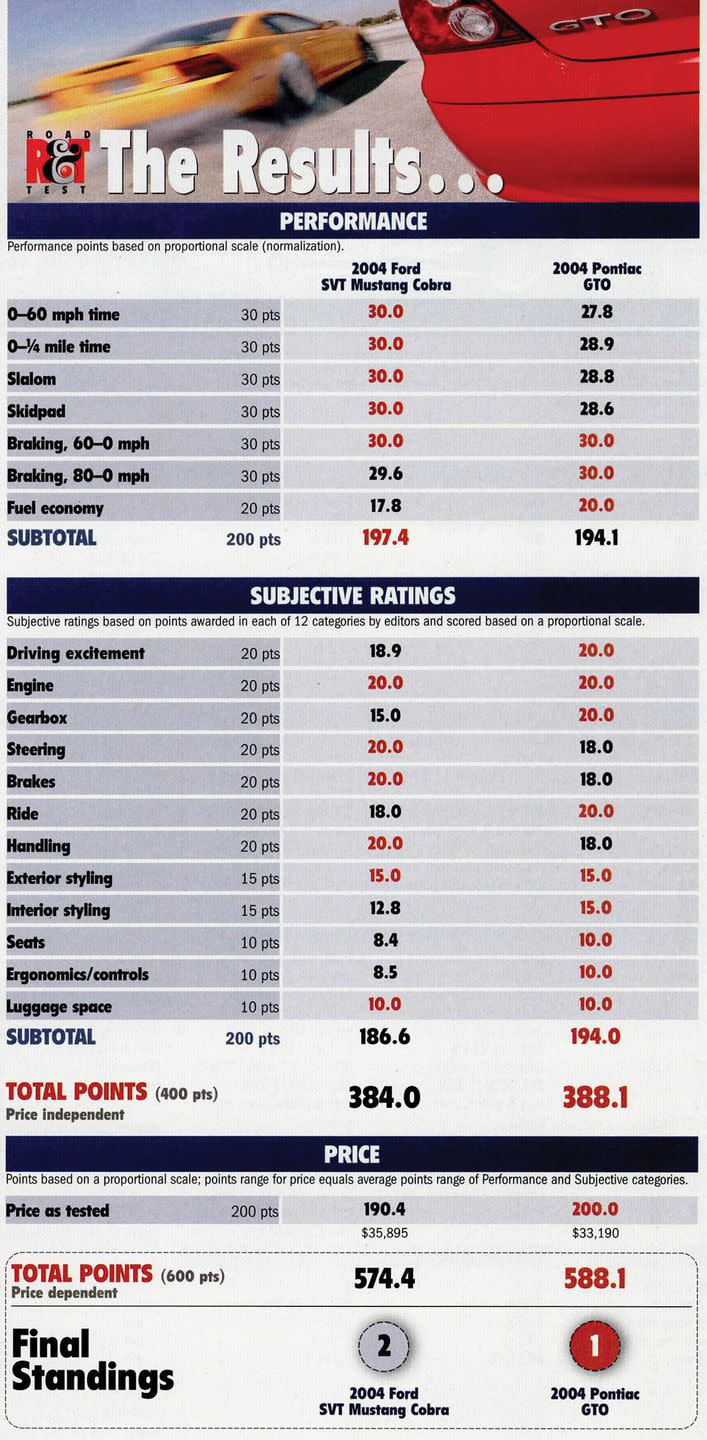
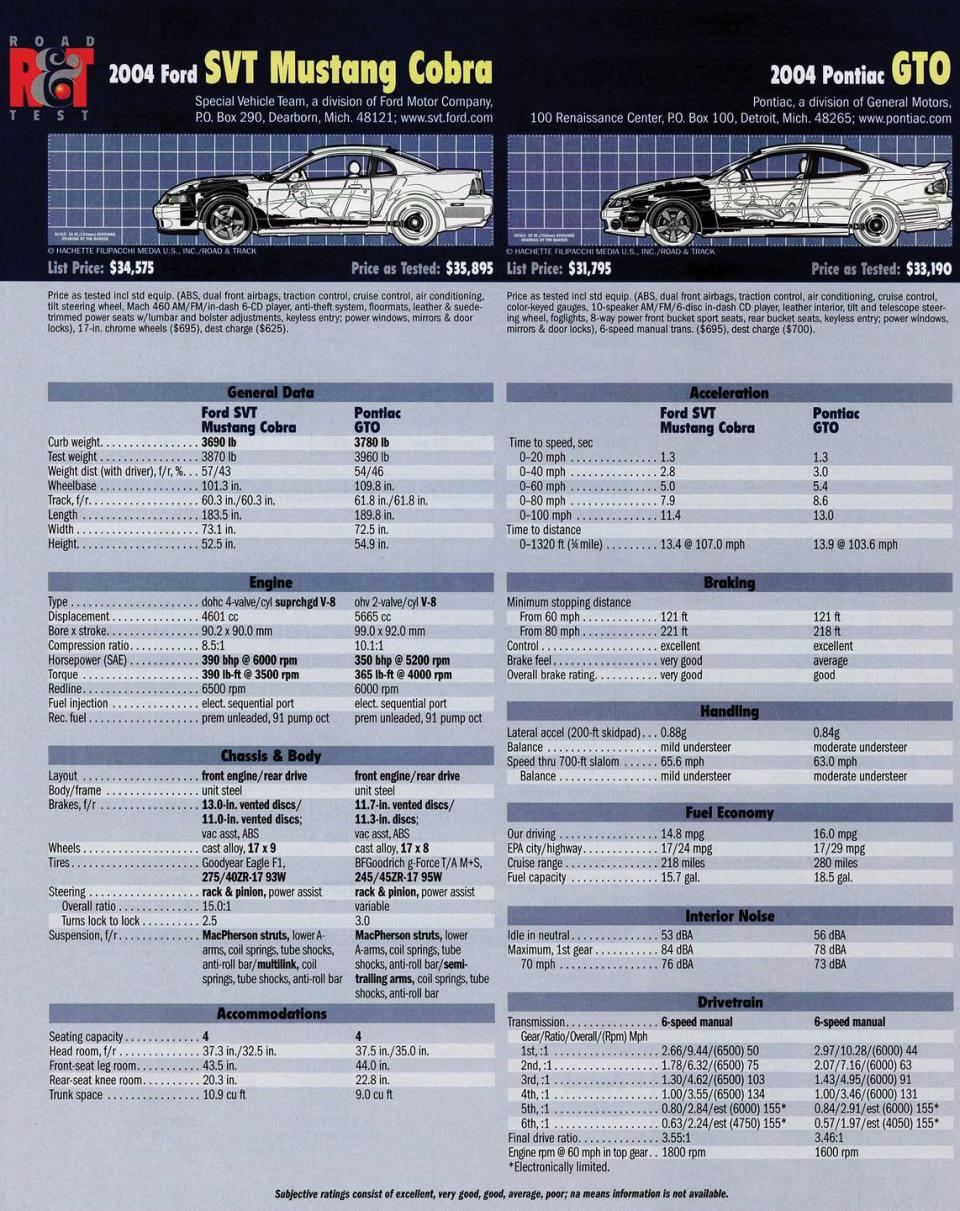
You Might Also Like

 Yahoo Autos
Yahoo Autos 